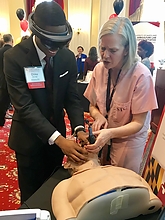 Researchers, clinicians and students representing 20 collaborative programs between the University of Maryland, College Park, and the University of Maryland, Baltimore, were in Annapolis yesterday, highlighting the progress of their work involving emergency medicine, community policing, computational biology, and more.
Researchers, clinicians and students representing 20 collaborative programs between the University of Maryland, College Park, and the University of Maryland, Baltimore, were in Annapolis yesterday, highlighting the progress of their work involving emergency medicine, community policing, computational biology, and more.
The programs were all jumpstarted by the University of Maryland Strategic Partnership: MPowering the State,, known as MPower, with representatives from each program on hand to give talks and answer questions from Maryland state legislators, legislative staff members, and several members of the University System of Maryland Board of Regents.
“I am so grateful for all of you, for what you have helped accomplish—to bring the essence of two universities that are completely complimentary, together,” UMCP President Wallace Loh said at the event.
Since its inception seven years ago, MPower has helped secure more than $164 million in funding from external agencies through more than 500 joint research proposals.
Two of the centers involved in yesterday’s activities are based in the University of Maryland Institute for Advanced for Advanced Computer Studies: the Maryland Blended Reality Center (MBRC) launched in 2017, and the Center for Health-related Informatics and Bioimaging (CHIB), launched in 2013.
MBRC members demonstrated four of their major research projects: improving emergency medical care with augmented reality (AR); experiencing opera from multiple viewpoints in virtual reality (VR); military training in VR; and combining VR with music for non-opioid pain management.
Currently, medical procedures that use video monitor feeds require physicians to look back and forth between the patient and the monitor, meaning that they’re not paying attention to the patient at all times, said Dr. Sarah Murthi, an associate professor of surgery in the University of Maryland School of Medicine and trauma surgeon at the R Adams Cowley Shock Trauma Center.
MBRC has developed an AR program that allows the physician to observe ultrasound imaging data without looking away from the patient.
MBRC also showed how AR can be used in an emergency procedure when the patient’s airway is compromised, and the physician must quickly insert an intubation tube to hook up a patient to a ventilator. (See photo)
Researchers from CHIB were available to discuss several of their collaborative projects that include: utilizing non-traditional water sources safely for agriculture; analyzing DNA strands that could pose a biological threat; developing computational tools to assess mental illness; and creating a mobile system to track the spread of respiratory diseases.
—Story by Maria Herd